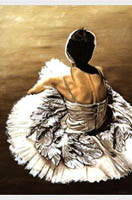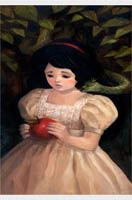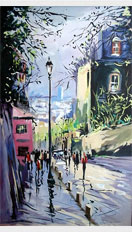J. M. W. Turner
Joseph Mallord William Turner (born in Covent Garden, London on April 23, 1775 (exact date disputed), died December 19, 1851) was an English Romantic landscape artist, whose style can be said to lay the foundations for Impressionism.
Life and career
His father, William Turner, was a wig-maker who later became a barber.
His mother, Mary Marshall, a housewife, became increasingly mentally
unstable during his early years, perhaps in part due to the early
death of Turner's younger sister in 1786. She died in 1804, having
been committed to a mental asylum.
Possibly due to the load placed on the family by these problems, the young Turner was sent in 1785 to stay with his uncle on his mother's side in Brentford, which was then a small town west of London on the banks of the Thames. It was here that he first expressed an interest in painting. A year later he went to school in Margate in Kent to the east of London in the area of the Thames estuary. At this time he had been creating many paintings, which his father exhibited in his shop window.
He was accepted into the Royal Academy of Art when he was only 15 years old. At first Turner showed a keen interest in architecture but was advised to keep to painting by the architect Thomas Hardwick (junior). Sir Joshua Reynolds, the president of the Royal Academy at that time, chaired the panel that admitted him. A watercolour of his was accepted for the Summer Exhibition of 1790 after only one year's study. He exhibited his first oil painting in 1796. Throughout the rest of his life, he regularly exhibited at the academy.
The fighting Temeraire tugged to her last berth to be broken up,
painted 1839.He is commonly known as "the painter of light".
Although renowned for his oils, Turner is also regarded as one of
the founders of English watercolour landscape painting.
One of his most famous oil paintings is The fighting Temeraire tugged to her last berth to be broken up, painted in 1839, which hangs in the National Gallery, London. See also The Golden Bough.
Turner travelled widely in Europe, starting with France and Switzerland in 1802 and studying in the Louvre in Paris in the same year. He also made many visits to Venice during his lifetime. He never married, although he had a mistress, Sarah Danby, by whom he had two daughters.
As he grew older, Turner became more eccentric. He had few close friends, except for his father, who lived with him for thirty years, eventually working as his studio assistant. His father died in 1829, which had a profound effect on him, and thereafter he was subject to bouts of depression.
Rain, Steam and Speed - The Great Western Railway painted (1844).He
died in his house in Cheyne Walk, Chelsea on 19 December 1851. At
his request he was buried in St Paul's Cathedral, where he lies
next to Sir Joshua Reynolds. His last exhibition at the Royal Academy
was in 1850.
Style
Turner's talent was recognized early in his life, becoming a full
art academician at the age of 23. Financial independence allowed
Turner to innovate and create paintings that astonished many. According
to David Piper's The Illustrated History of Art, his later pictures
were called "fantastic puzzles." However, Turner was still
recognized as an artistic genius: influential English art critic
John Ruskin described Turner as the artist who could most "stirringly
and truthfully measure the moods of Nature." (Piper 321)
Like most Romanticists, the awesome power of nature was a consistent motif in Turner's works. He focused on the violent power of the sea, as seen in Dawn after the Wreck (1840) and The Slave-Ship (1840).
His first works, such as Tintern Abbey (1795) and Venice: S. Giorgio Maggiore (1819), stayed true to the traditions of English landscape. However, in Hannibal Crossing the Alps (1812), his emphasis on the destructive power of nature had already come into play. Turner perfected his technique to develop the theme through his years. His distinctive style of painting, in which he used watercolor technique with oil paints, created lightness, fluency, and dissappearing atmospheric effects. (Piper 321)
In his late years, he used oils even less, and turned to almost pure light with shimmering color. Examples of his later style can be seen in Rain, Steam and Speed - The Great Western Railway, where the objects are barely recognizable.
Turner, along with John Constable, was at the forefront of English painting by his later years, and both were popular in France as well. Impressionists carefully studied his techniques, although they sought to diminish the power of his paintings. In the modern art era, advocates of abstract art were also influenced by Turner.
Legacy
Turner left a large fortune that he hoped would be used to support
what he called "decaying artists". His collection of paintings
was bequeathed to the British nation, and he intended that a special
gallery would be built to house them. This did not come to pass
owing to a dispute by his descendants over the legality of his will.
Twenty years after his death, the paintings were given over to the
British Museum. A prestigious annual art award, the Turner Prize,
created in 1984, was named in Turner's honour.







